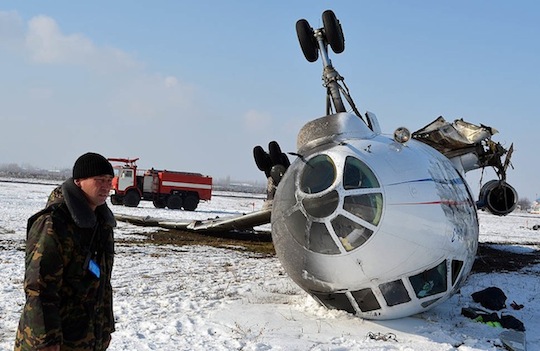
Osh, Kyrgyzstan — A security guard stands near an overturned Russian-made Tupolev Tu-34 passenger jet at the airfield outside the southern Kyrgyz city of Osh, a day after the plane crash. The packed passenger jet flipped over and caught fire on landing. PHOTOGRAPH BY: JILDIZ BEKBAEVA / AFP / GETTY IMAGES
It was a rough but lucky landing (both “rough and “lucky” are strong understatements here) when a Soviet-built Tupolev (Tu-134) crash landed in dense fog in the city of Osh in southern Kyrgyzstan. According to The Washington Post 82 passengers and 6 crew members were evacuated, 31 of them were injured and 17 hospitalized. Miraculously everyone on board survived. No doubt, the local emergency services deserve some major kudos for reacting quickly, killing the fire and safely evacuating everybody from the scene.
RT reports there were about a dozen of children among the passengers. One of them, a seven-month-old girl, was diagnosed with a head injury and concussion. The Ministry of Transportation of Kyrgyzstan said that the crashed vehicle was working its last days, with its airworthiness due to expire on 19 January. It was also reported that the aircraft had been manufactured in 1979 and was not equipped with modern navigation systems such as GPS. Reports say one of the likely causes is a mistake made by the pilot operating the aircraft, but the accident is still to be investigated.
Here’s the description of the crash from The Aviation Herald. Note that this report on the number of passengers and crew on board of the aircraft differs from other sources. “An Altyn Air (alias Kyrgyzstan Altyn) Tupolev TU-134A, registration EX-020 performing flight QH-3 from Bishkek to Osh (Kyrgyzstan) with 73 passengers and 6 crew, suffered a hard landing resulting in the right main gear collapse, right main wing separation and the airplane rolling on its back while landing on Osh’s runway 12 in fog and low visibility around 12:15L (06:15Z), official times of landing varying from 12:05L to 12:48L. The aircraft came to a stop on soft ground about 10 meters off the right runway edge. A fire fed by a fuel leak off the left wing erupted which was quickly extinguished by airport emergency services. One passenger received serious injuries, 24 people received minor injuries (concussions, bruises), 16 of which were taken to local hospitals.”
We know that the bird involved in the crash is a Tupolev-134. Here’s a little blurb about the Tu-134s from the Associated Press: The twin-engined Tu-134, along with its larger sibling the Tu-154, has been the workhorse of Soviet and Russian civil aviation since the 1960s, with more than 800 planes built. It also has remained in service with many post-Soviet carriers. In recent years, Russia and other former Soviet nations have had some of the world’s worst air traffic safety records. Experts blame poor maintenance of the aging aircraft, weak government controls, insufficient pilot training and a cost-cutting mentality.
This type of Soviet-built aircraft was infamously involved in several deadly crashes. Here’s more info on Tupolev crashes. More recently, this past June a Tu-134 crashed in northern Russia killing 43 passengers, but it appears that a drunken pilot was at fault. Earlier in 2011 at least 43 were injured when a Tu-154B carrying 124 people, burst into flames before take-off from Surgut, Russia. And of course another painful reminder of Soviet-era aviation was the crash of a Tu-154 plane near Smolensk that killed Polish President Lech Kaczynski and 95 other people in April of 2010. Pilot error was clearly at fault here – both captain and first officer ignored numerous instrumentation warnings including verbal commands from the plane’s terrain awareness warning system (TAWS) warning the pilots to “PULL UP.” Procedure requires any pilot who receives that warning from the TAWS to immediate pull up and throttle to maximum to avoid an imminent collision with the ground. Clearly both pilots heavily deviated from standard safety protocols.
Back to our Kygryztan Air crash. Until the final findings of the commission are published it’s too early to draw any conclusions, although bad weather conditions had something to do with it. The Tupolevs are aging and even though in the past they might have been sound and well engineered planes, they have become outdated compared to modern aircraft. Not to mention they are not being properly maintained as they are mostly employed in cash-strapped countries. Modern day aircraft are sophisticated enough to be able to land automatically without human intervention more akin to a tram with a stop-and-go button. No Cold War-era planes can compete with that. In an initiative to keep its skies safe, the E.U. banned airlines it deems unsafe from operating in European airspace and according to its website this includes the airline that was involved in the Kyrgyz crash.
There’s a lot of chatter and opinions on aviation websites debating the airworthiness of Soviet-built planes and the skill of Soviet/post-Soviet pilots. I found one post on The Aviation Herald board about the Osh accident particularly interesting. “There has been a lot of pressure on the pilot to fly (as the only road linking the northern and southern parts of the country has been often closed recently because of snow and avalanches. Flying is the only way to get to Bishkek in a reasonable time (road 14 to 16 hours now for a flight that takes 40 minutes). A TU 134 with its navigation equipment should not have been clear on that day. That the pilot was able to bring down the plane speaks for his skills and the robustness of the plane. A similar crash with one of the old Boeing 737 they use here had been fatal for sure.”
One of my colleague here at the Foreign Policy Blogs recently wrote a post in a similar vein about the safety of Soviet-made planes.
Here are more photos of the crash.